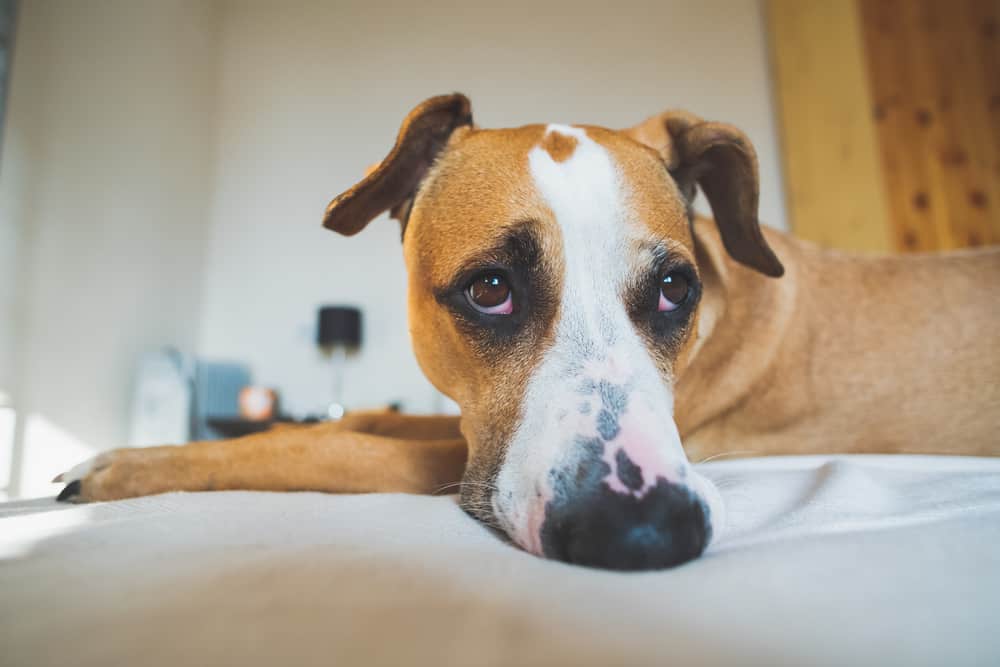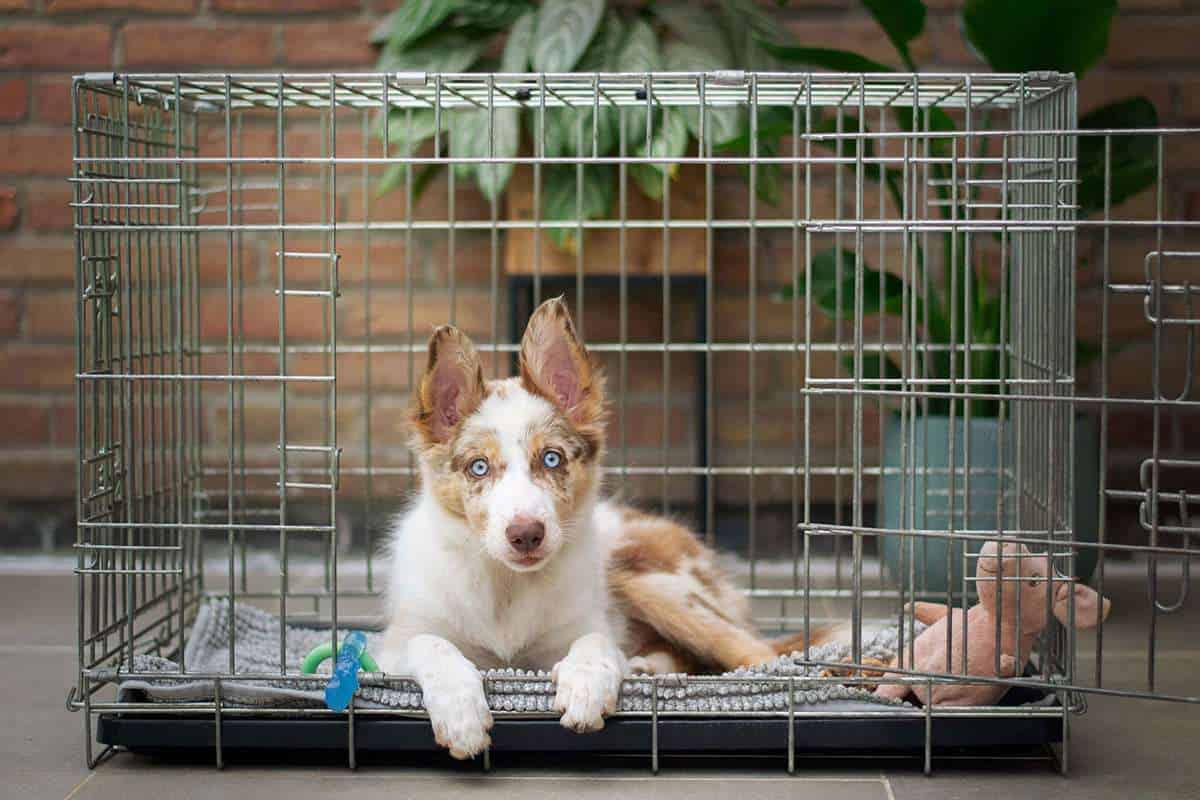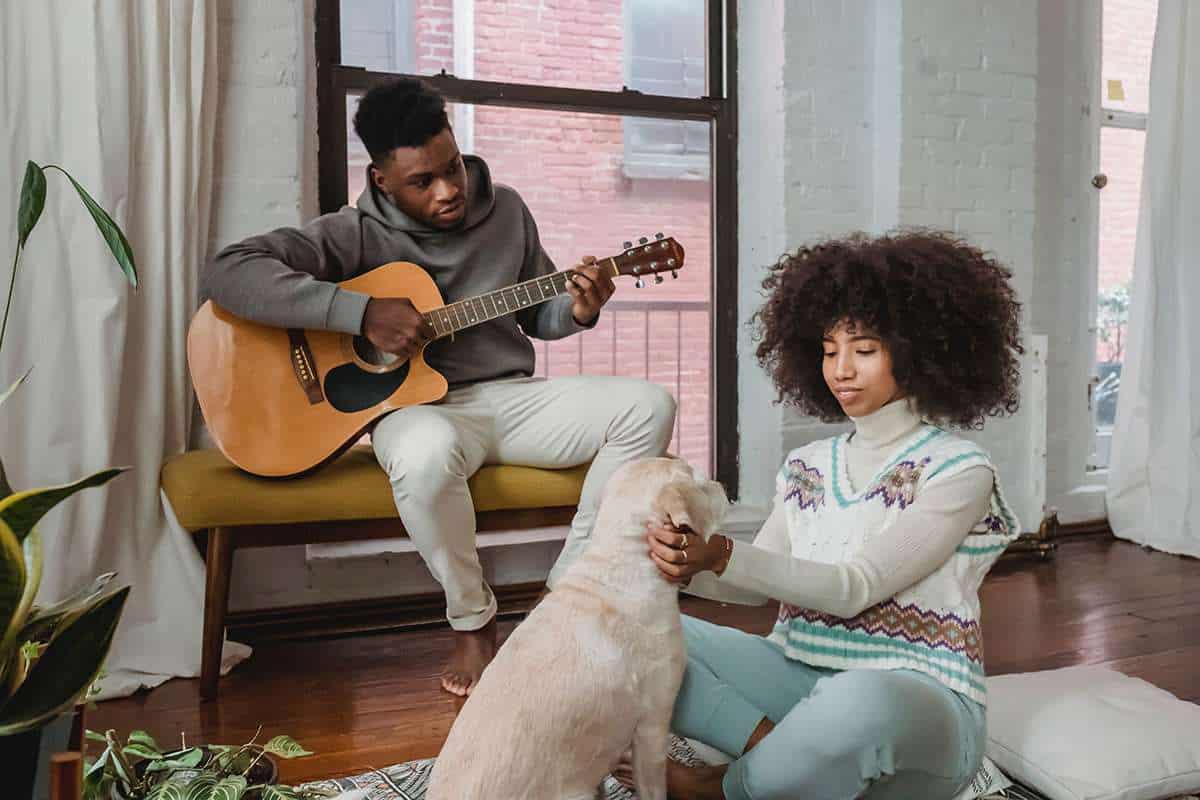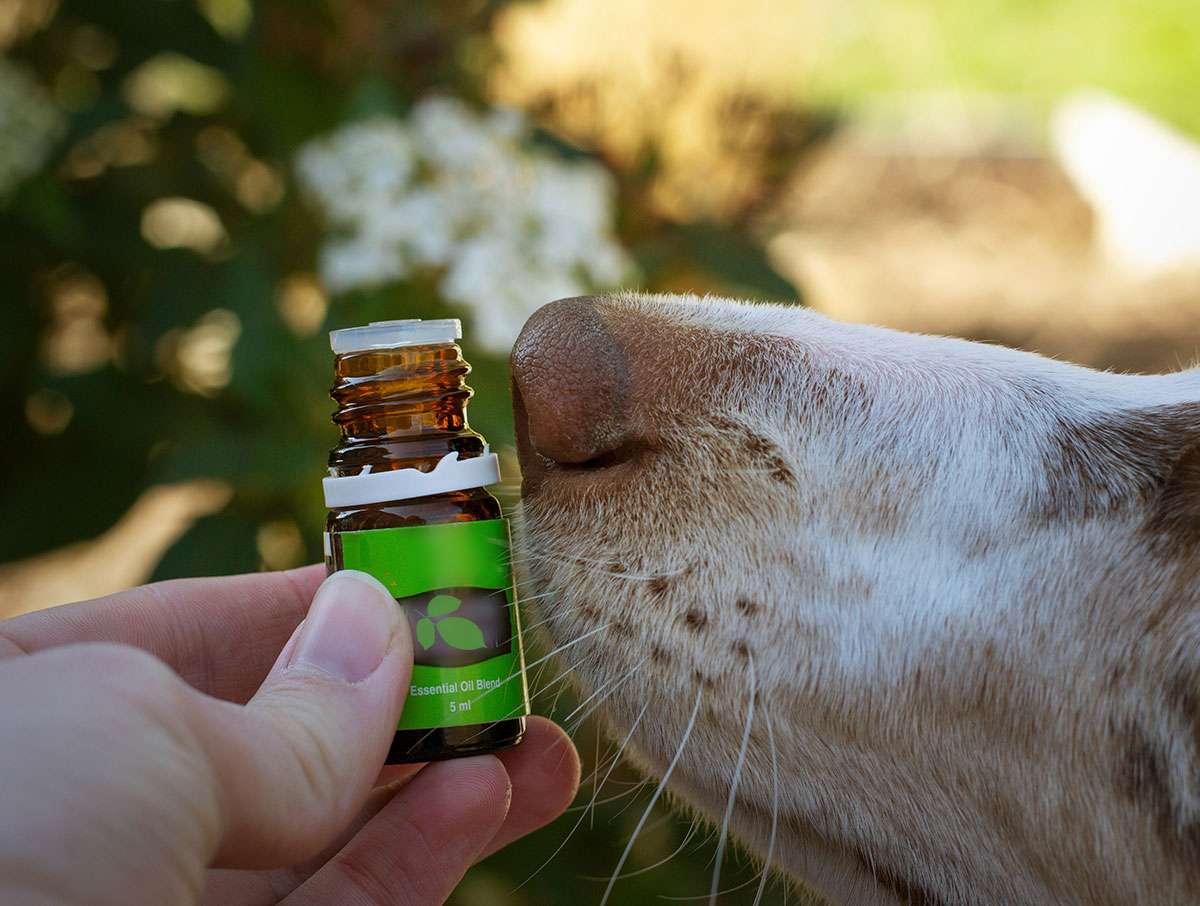As a devoted dog owner, understanding your pet’s emotions is paramount to ensuring they lead a happy, fulfilling life. This is especially true when it comes to dog anxiety.
Dog anxiety is a behavioral and emotional condition in dogs characterized by symptoms like excessive barking, urination or defecation in the house, destructive chewing, and other signs of distress often triggered by fear, separation, or environmental changes.
Their anxiety can be caused by situations like:
- being away from their owners
- facing new environments or situations
- hearing loud noises like thunder or fireworks
It’s heartbreaking to see your dog upset or in pain from anxiety because you feel for them. Struggling to help your anxious dog may also bring you emotional distress.
However, with patience and dedication, you can help your anxious dog lead a happier, balanced life.
In this article:
What Causes Anxiety in Dogs?
Dogs are social animals and are known for their ability to interact and communicate with humans in a special way. And just like humans, dogs can experience anxiety.
Their anxiety can stem from factors like genetics, past events, fear, aging, poor socialization, or routine/environment changes.
The first step in helping your dog feel more relaxed is to identify the root cause of their anxiety.
Noise Anxiety: Sudden and unpredictable loud sounds like fireworks, thunderstorms, and gunshots can be overwhelming for dogs and trigger a fear response. This fear can develop into noise anxiety which can be difficult for dogs to overcome without help.
Separation Anxiety: Dogs are social animals by nature. They become attached to their human family members and view them as part of their “pack.” As social animals, they rely on these relationships for companionship, security, and emotional support.
Dogs with strong human-dog bonds may experience separation anxiety when their owner is away. The severity of separation anxiety varies among individual dogs.
Some dogs might exhibit mild signs of distress. Others may display their anxiousness by excessive barking, destructive actions, house soiling, or attempts to escape.
Travel anxiety: Travel can be a source of anxiety in dogs, especially when traveling in a car or plane. This can be heightened if the dog isn’t travel-experienced or has had past bad experiences.
Social Anxiety: Dogs with social anxiety may feel nervous, fearful, or overwhelmed in social situations. This is particularly tough for dogs lacking proper socialization or with past negative experiences. Social anxiety can lead to a variety of undesirable behaviors, such as excessive barking, growling, hiding, or even aggression.
Aging: Older dogs may develop health issues such as arthritis, heart problems, or declining vision and hearing. These conditions can cause discomfort, pain, or disorientation, which may contribute to increased anxiety.
Another factor is cognitive decline. Aging dogs can experience cognitive dysfunction syndrome, similar to dementia in humans. This decline in cognitive function can result in confusion, disorientation, and memory loss, leading to increased anxiety and restlessness.
Signs and Symptoms
One of the most common signs of anxiety in dogs is excessive barking. Excessive barking can also be a sign of boredom or frustration.
Another common sign of dog anxiety is destructive behavior. Dogs may chew on furniture, carpets, or walls when they are anxious. This behavior is a way for dogs to release pent-up energy and frustration.
Panting and pacing are also typical signs of anxiety in dogs. In some cases, pacing and panting may be triggered by physical discomfort or pain. That’s why it’s important to rule out any underlying medical conditions.
Dogs may howl to express their anxiety, or to seek comfort from their owners or other dogs in the area.
Another sign of dog anxiety is avoidance behavior. It’s a coping strategy where dogs remove themselves from stressful, fearful, or anxiety-inducing situations.
Examples of avoidance behaviors in dogs include:
An anxious dog may involuntarily urinate or defecate due to loss of bladder or bowel control. This response is known as “stress-induced incontinence” and is a common symptom of anxiety in dogs.
Finally, some dogs may show signs of anxiety through their body language. These signs can include shaking, trembling, or cowering.
Ways to Calm an Anxious Dog
There are several ways that you can help a dog with anxiety. First, find out what makes your dog anxious, like loud noises, new places, or being away from you.
Create a calm and safe space at home with a comfy bed, soft music, and their favorite toys. You can also use calming sprays or supplements to help them relax. Regular exercise and activities that keep their minds busy can help reduce stress. Going for walks or playing with puzzle toys can be helpful.
Reward your dog for staying calm in situations that make them anxious. This can help them feel more confident over time. If your dog’s anxiety is very bad, talk to a vet or animal behaviorist for help. They might need medication to manage their anxiety.
Remember to stay calm and patient when helping your dog. If you’re anxious, your dog can feel it and may become more anxious too. With time and patience, you can help your dog feel more at ease.
Natural Remedies for Dog Anxiety
Natural remedies and supplements can help calm your dog’s anxiety. It’s important to talk to your vet before giving your dog any new supplements or herbal remedies. They can tell you the right dosage and possible side effects.
Derived from hemp, CBD oil can aid dogs and humans with anxiety. Available in various strengths and flavors, it can be administered orally or mixed in dog food.
Another natural dog anxiety supplement, L-theanine, is an amino acid shown to reduce anxiety in dogs. It works by elevating dopamine and GABA, brain chemicals that affect mood and anxiety.
Melatonin is a hormone that helps with sleep and mood. It can help calm your dog’s anxiety, especially if they have separation anxiety or fear of loud noises.
Herbal remedies can also help with dog anxiety. Chamomile can calm dogs and can be given as tea or a supplement. Valerian root is another herb that helps reduce anxiety in dogs. You can give it as a capsule or liquid.
Lavender oil, used in a diffuser, spray, or diluted on your dog’s fur, can help relieve stress. Always start with a small amount of pure essential oil to prevent any negative reactions.
Some products have pheromones, which can calm dogs. These products come in sprays, collars, and diffusers and can help with separation anxiety, travel anxiety, and other stress. Adaptil and Feliway are examples of helpful pheromone products.
Again, always talk with your vet before giving your dog any new supplements or herbal remedies. They can help you with the right dosage and side effects.
Medical Treatments for Dog Anxiety
If your dog’s anxiety is severe, a vet may prescribe medication to help. There are different medicines for dog anxiety, like benzodiazepines, SSRIs, and tricyclic antidepressants.
Benzodiazepines help by increasing GABA in the brain, which lowers anxiety. They can help with strong anxiety episodes but aren’t used for long-term anxiety. Examples are alprazolam (Xanax) and diazepam (Valium).
SSRIs help by increasing serotonin in the brain, which can lower anxiety and make your dog feel better. They are used for long-term anxiety and might take a few weeks to work. Examples are fluoxetine (Prozac) and sertraline (Zoloft).
Tricyclic antidepressants can also treat dog anxiety. They help by increasing serotonin and norepinephrine in the brain, which can lower anxiety and make your dog feel better. Examples are amitriptyline (Elavil) and clomipramine (Anafranil).
All medicines can have side effects, so work closely with your vet to watch your dog’s reaction. Follow your vet’s instructions and don’t stop or change the medicine without talking to them first.
Can Dogs Grow Out of Anxiety?
Some dogs might grow out of anxiety, especially if it’s tied to a certain age or event. For example, puppies may initially have separation anxiety. As they mature and adapt to their home, their anxiety may diminish.
In most cases though, dog anxiety lasts a long time and needs ongoing care.
Even if a dog seems to grow out of anxiety, the symptoms might just be hidden.
Also, dogs can get anxiety later in life, especially if something big or scary happens. In these cases, the anxiety won’t just go away and needs professional help to handle.
Is There a Cure?
Sadly, there’s no cure for dog anxiety. Anxiety is complicated and can be caused by many things, like genetics, past experiences, and stress. Treatments can help with anxiety symptoms, but they don’t cure the problem.
The goal of treating dog anxiety is to help with symptoms and make the dog’s life better. This might include using medicine, training, and changes to the environment to lower stress.
In some cases, dog anxiety might be something you need to manage for their whole life.
How Can I Prevent My Dog from Developing Anxiety?
To prevent dog anxiety, it’s important to understand the underlying causes and take action to minimize or eliminate them.
For example, providing a safe and secure environment for the dog can help to reduce separation anxiety. Providing plenty of exercise and mental activities can also help to avoid anxiety in dogs.
Socializing your dog is also important in preventing anxiety. Early exposure to people, animals, and places lowers the risk of anxiety in new situations later on.
Acting early can prevent more serious anxiety issues and improve your dog’s overall well-being.
Are Certain Dog Breeds More Prone to Anxiety?
Researchers have found that genetics can results in anxiety in dogs, but the environment and experiences are important factors too.
For example, timid or sensitive dogs can be more susceptible to anxiety in stressful situations.
Labrador Retrievers are famous for their devotion and strong bond with their owners. They were bred to work closely alongside humans, which makes them more susceptible to separation anxiety when left by themselves.
Border Collies are smart, lively dogs needing plenty of mental and physical activity. If left alone without appropriate stimulation, they might develop separation anxiety.
Shetland Sheepdogs are a herding breed known for their intelligence and sensitivity. They may be more prone to anxiety due to their breeding history and temperament.
Recognized for their loyalty and deep connection with their owner, German Shepherds were initially bred for herding and guarding purposes. This background makes them susceptible to separation anxiety when they cannot be with their owner.
Vizslas are affectionate, loyal, and form strong attachments to their human family members. This breed thrives on human companionship and may become anxious or stressed when left alone for extended periods.
Here are a few breeds that have been mentioned in anecdotal reports as being prone to anxiety:
Chihuahuas can be cautious around unfamiliar people or other dogs. Their small stature might cause them to feel insecure in some circumstances, resulting in increased anxiety.
Jack Russell Terriers may occasionally display anxious tendencies, especially when they don’t receive enough mental and physical engagement.
Poodles may be more prone to anxiety, especially when not adequately socialized or introduced to diverse surroundings.
Cocker Spaniels can be more susceptible to anxiety, particularly when not given ample socialization and training.
It’s important to remember that while anxiety may be hereditary, it is not a guarantee. Just because a breed has a higher risk of anxiety doesn’t necessarily mean a dog will develop the condition.
Proper socialization, training, and environmental management can all help reduce anxiety risk in dogs with a genetic predisposition.
How Can I Make My Dog Feel Safe During an Anxiety Attack?
Seeing your dog affected by anxiety can be upsetting. However, there are several things you can do to help them feel safe and secure during the episode.
First, try to stay calm and speak to your dog in a soothing voice. Dogs are very sensitive to human emotions and can sense our stress and anxiety. Remaining calm can help reassure them that everything is fine.
Next, make a quiet and comfortable environment for your dog. Dimming the lights, blocking outside stimuli, and giving your dog a cozy bed or blanket to snuggle in can help.
Think about playing soothing music or using a white noise machine. These can calm your pooch and drown out loud or startling noises that trigger anxious feelings.
Another way to help your dog feel safe during an anxiety attack is to participate in calming activities with them. This could involve gentle petting or massage, or playing with a calming toy like a puzzle feeder or chew toy.
These activities can distract your dog from their anxiety and create a positive and calming experience.
It’s also crucial not to punish or scold your dog during an anxiety attack.
This can make their anxiety worse and make them feel more distressed.
Instead, offer plenty of praise and positive reinforcement when they display calm behavior.
If your dog has frequent or severe anxiety attacks, consult a veterinarian or animal behaviorist. They can develop a comprehensive management plan, offering the best chance for long-term management of the condition.
Remember that understanding and patience are key when dealing with an anxious dog. Changes might take some time, but in the end the effort will be worth it for you and your dog.
For further information on dog anxiety, check out these sites:
- AKC Understanding, Preventing, and Treating Dog Anxiety
- The Humane Society of the United States – How to help a dog with anxiety




Leave a Reply